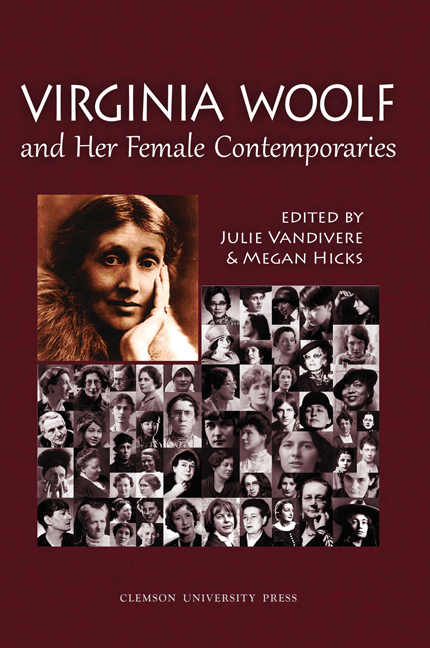Book contents
- Frontmatter
- Table of Contents
- Introduction
- Acknowledgments
- Abbreviations
- Who Are Virginia Woolf's Female Contemporaries?
- Virginia Woolf's Cultural Contexts
- Virginia Woolf's Contemporaries Abroad
- Virginia Woolf's Contemporaries at Home
- “The Squeak of a Hinge”: Hinging and Swinging in Woolf and Mansfield
- “People must marry”: Queer Temporality in Virginia Woolf and Katherine Mansfield
- The Weight of “Formal Obstructions” and Punctuation in Mrs. Dalloway and Pointed Roofs
- Advise and Reject: Virginia Woolf, the Hogarth Press, and a Forgotten Woman's Voice
- Florence Melian Stawell and Virginia Woolf: Home-front Experience, The Price of Freedom, and Patriotism
- Intimations of Cosmic Indifference in Virginia Woolf 's Orlando and Olive Moore's Spleen
- “Could I sue a dead person?”: Rebecca West and Virginia Woolf
- Splintered Sexualities in Rebecca West's The Return of the Soldier, Virginia Woolf 's Mrs Dalloway, and Sylvia Townsend Warner's “A Love Match”
- Sexual Cryptographies and War in Virginia Woolf 's Between the Acts and Elizabeth Bowen's The Heat of the Day
- Tribute to Jane Marcus
- Notes on Contributors
- Conference Program 223
The Weight of “Formal Obstructions” and Punctuation in Mrs. Dalloway and Pointed Roofs
from Virginia Woolf's Contemporaries at Home
- Frontmatter
- Table of Contents
- Introduction
- Acknowledgments
- Abbreviations
- Who Are Virginia Woolf's Female Contemporaries?
- Virginia Woolf's Cultural Contexts
- Virginia Woolf's Contemporaries Abroad
- Virginia Woolf's Contemporaries at Home
- “The Squeak of a Hinge”: Hinging and Swinging in Woolf and Mansfield
- “People must marry”: Queer Temporality in Virginia Woolf and Katherine Mansfield
- The Weight of “Formal Obstructions” and Punctuation in Mrs. Dalloway and Pointed Roofs
- Advise and Reject: Virginia Woolf, the Hogarth Press, and a Forgotten Woman's Voice
- Florence Melian Stawell and Virginia Woolf: Home-front Experience, The Price of Freedom, and Patriotism
- Intimations of Cosmic Indifference in Virginia Woolf 's Orlando and Olive Moore's Spleen
- “Could I sue a dead person?”: Rebecca West and Virginia Woolf
- Splintered Sexualities in Rebecca West's The Return of the Soldier, Virginia Woolf 's Mrs Dalloway, and Sylvia Townsend Warner's “A Love Match”
- Sexual Cryptographies and War in Virginia Woolf 's Between the Acts and Elizabeth Bowen's The Heat of the Day
- Tribute to Jane Marcus
- Notes on Contributors
- Conference Program 223
Summary
Virginia Woolf 's critical writing repeatedly emphasizes the spatial valence of literary fiction. “A book is not made of sentences laid end to end, but of sentences built, if an image helps, into arcades or domes,” she writes in A Room of One's Own (1929); “[a]nd this shape too has been made by men out of their own needs for their own uses” (76). Woolf anticipates that a woman writer will “knock” the novel “into shape for herself when she has the free use of her limbs” (77), articulating a connection between a novel's generic structure and a writer's control over physical forms. The form of the book, as constructed in its sentences, engages and reflects the experiences and structures of the bodies making the books. At the same time, in A Room of One's Own as well as in her book reviews and essays, Woolf positions her own experimental narrative structures, and the selves those structures represent, against those developed by her female contemporaries, including Dorothy Richardson. Woolf reports in her diary that she seeks to avoid “the damned egotistical self, which ruins Joyce & Richardson to my mind” (D2:14), and in her reviews of later installations of Richardson's opus Pilgrimage, Woolf criticizes the superficiality of Richardson's character development and narration (“The Tunnel” 11).
My concern here is how these writers’ distinct approaches to narration and self-making are reflected in the scaffolding of the sentences of the books themselves; specifically, I want to suggest that Woolf 's and Richardson's approaches to character, narrator, body, and self are reflected in their uses of punctuation. Mrs. Dalloway's (1925) punctuation appears fairly conventional even within Woolf 's oeuvre—there are no variations of blank space here, as we find in Jacob's Room (1922), nor the crotchets of To the Lighthouse (1927)—yet in comparison to Pointed Roofs (1915), the first installment of Richardson's opus Pilgrimage, Woolf 's novel presents in its syntactical structures a drastically different approach to narrated embodiment. The punctuational differences lead to different readerly experiences of the page and of the minds represented on those pages; thinking about these structures of access and mobility, registered linguistically and visually, suggests new avenues of thinking about how bibliographical and narrative forms reflect sharp differences in modernist writers’ approaches to gender, mobility, and voice.
- Type
- Chapter
- Information
- Virginia Woolf and Her Female Contemporaries , pp. 163 - 169Publisher: Liverpool University PressPrint publication year: 2016



